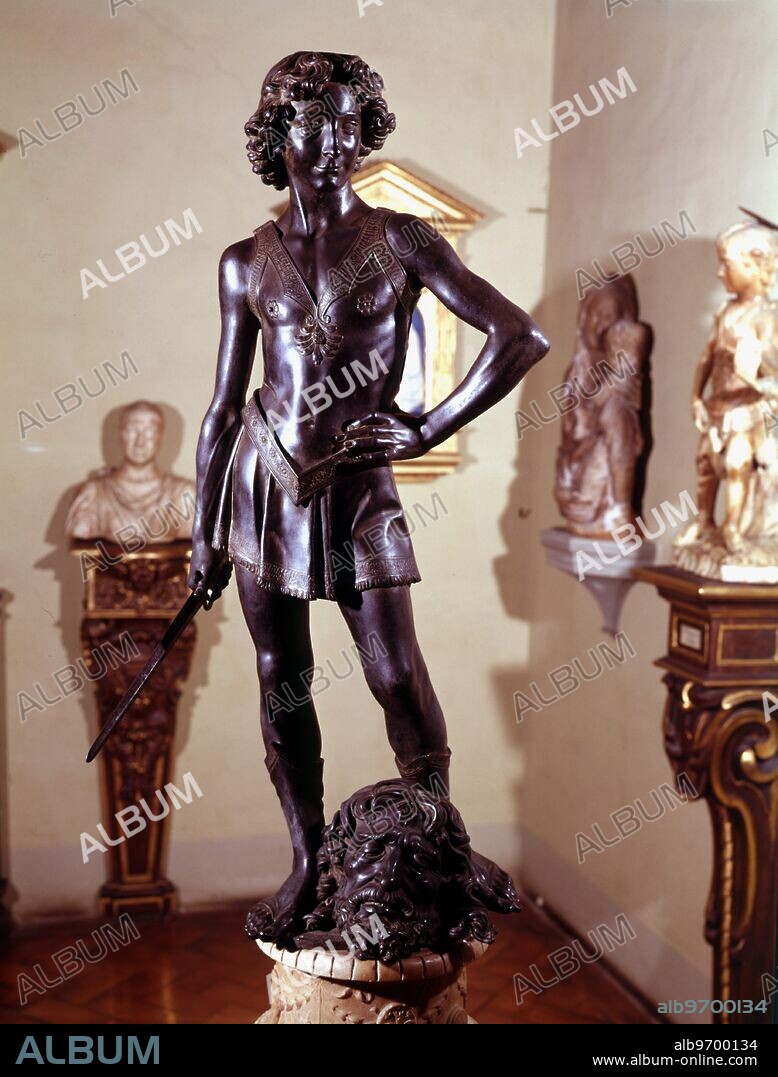alb9700134
Andrea Verrocchio 'David' - Museum Bargello, Florence, Italy.. Andrea del Verrocchio, born Andrea di Michele di Francesco de' Cioni, (c. 1435 -1488) was an influential Florentine sculptor, goldsmith and painter who worked at the court of Lorenzo de Medici. His pupils included Leonardo da Vinci, Perugino, Ghirlandaio and Sandro Botticelli, but he also influenced Michelangelo. He worked in the serenely classic style of the Early-High Renaissance.. Andrea del Verrochio's bronze statue of David was most likely made between 1473 and 1475. It was commisioned by the Medici family. It is sometimes claimed that Verrocchio modelled the statue after a handsome pupil in his workshop, the young Leonardo da Vinci. The statue demonstrates the young King David triumphantly posing over the head of the slain Goliath. The bronze was initially installed in Palazzo Vecchio in 1476. Placement of Goliath's head has been a source of some debate for art historians. When exhibited at the National Gallery of Art, the head was placed between David's feet, as is the case in the statue's permanent home, the National Museum of the Bargello, in Florence, Italy. Another school of art historians have suggested that Verrocchio intended for Goliath's head to be placed to David's right, pointing to the diagonals of the ensemble. This placement was temporarily arranged at the National Gallery of Art, as well as Atlanta's High Museum, among others. David was intended as a representation of Florence, as both were more powerful than they appeared, and both the shepherd boy and Florence could be viewed as rising powers.. ©TopFoto

|
Zu einem anderen Lightbox hinzufügen |
|
Zu einem anderen Lightbox hinzufügen |



Haben Sie bereits ein Konto? Anmelden
Sie haben kein Konto? Registrieren
Dieses Bild kaufen.
Nutzung auswählen:

Untertitel:
Siehe automatische Übersetzung
Andrea Verrocchio 'David' - Museum Bargello, Florence, Italy.. Andrea del Verrocchio, born Andrea di Michele di Francesco de' Cioni, (c. 1435 -1488) was an influential Florentine sculptor, goldsmith and painter who worked at the court of Lorenzo de Medici. His pupils included Leonardo da Vinci, Perugino, Ghirlandaio and Sandro Botticelli, but he also influenced Michelangelo. He worked in the serenely classic style of the Early-High Renaissance.. Andrea del Verrochio's bronze statue of David was most likely made between 1473 and 1475. It was commisioned by the Medici family. It is sometimes claimed that Verrocchio modelled the statue after a handsome pupil in his workshop, the young Leonardo da Vinci. The statue demonstrates the young King David triumphantly posing over the head of the slain Goliath. The bronze was initially installed in Palazzo Vecchio in 1476. Placement of Goliath's head has been a source of some debate for art historians. When exhibited at the National Gallery of Art, the head was placed between David's feet, as is the case in the statue's permanent home, the National Museum of the Bargello, in Florence, Italy. Another school of art historians have suggested that Verrocchio intended for Goliath's head to be placed to David's right, pointing to the diagonals of the ensemble. This placement was temporarily arranged at the National Gallery of Art, as well as Atlanta's High Museum, among others. David was intended as a representation of Florence, as both were more powerful than they appeared, and both the shepherd boy and Florence could be viewed as rising powers.. ©TopFoto
Persönlichkeiten:
Bildnachweis:
Album / Tito Poggio / TopFoto
Freigaben (Releases):
Model: Nein - Eigentum: Nein
Rechtefragen?
Rechtefragen?
Bildgröße:
3662 x 4819 px | 50.5 MB
Druckgröße:
31.0 x 40.8 cm | 12.2 x 16.1 in (300 dpi)
Schlüsselwörter:
 Pinterest
Pinterest Twitter
Twitter Facebook
Facebook Link kopieren
Link kopieren Email
Email
